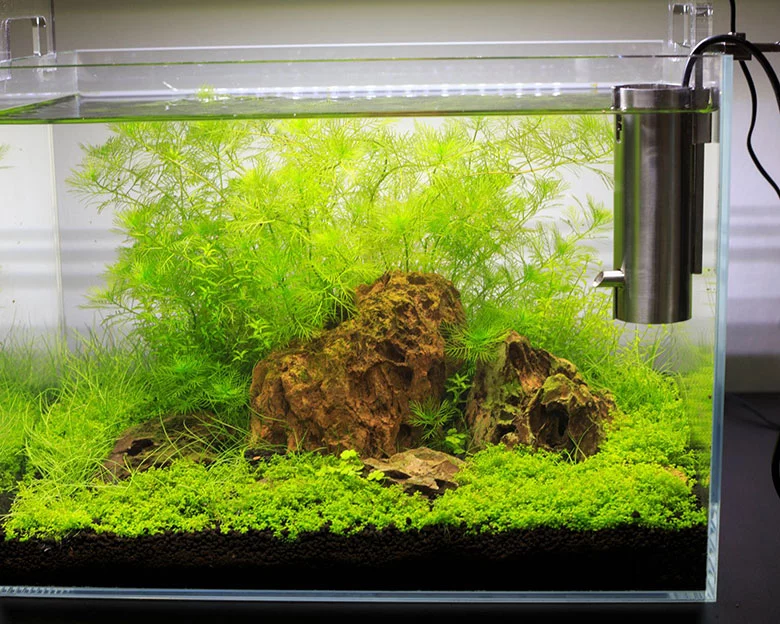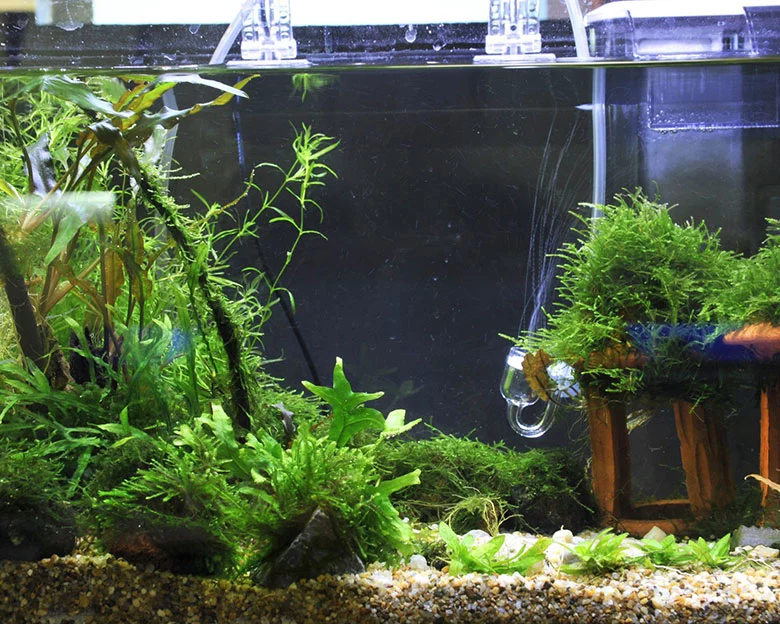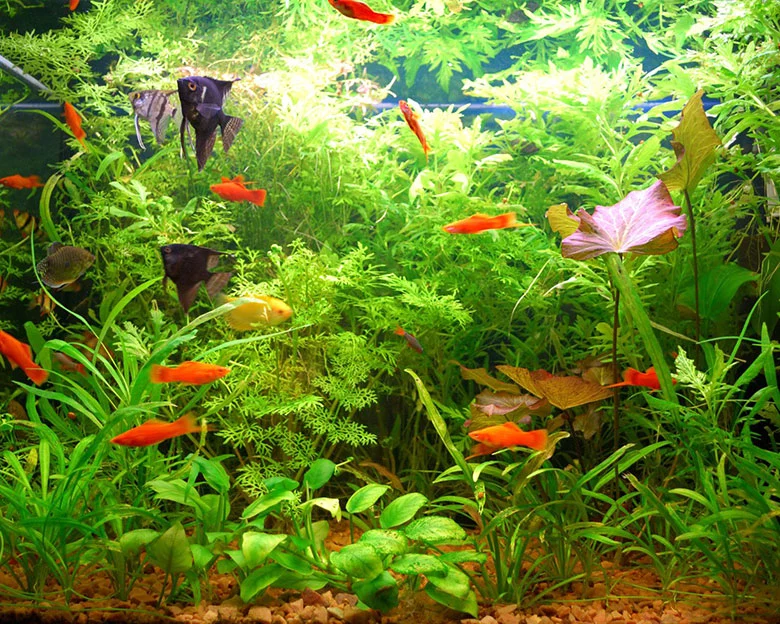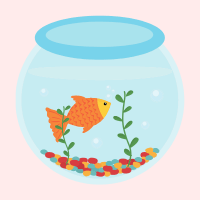If you want to create a beautiful and healthy planted aquarium, selecting the best substrate for planted tanks, which is widely regarded as the optimal choice, is absolutely essential. The substrate you choose can significantly impact the growth and health of your plants, as well as the well-being of your fish.
But with so many different types of substrates available, it can be difficult to know which one is right for your tank. That’s where this complete guide comes in.
In this article, we will take an in-depth look at the importance of substrate and explore the different types available on the market. We’ll also examine the specific needs of different plants and fish, so you can decide which substrate is best for your tank.
Whether you’re a seasoned aquarium enthusiast or just starting out, this guide will provide you with all the information you need to choose the perfect substrate for your planted tank. So let’s dive in and explore the world of aquarium substrates!
Key Takeaways
- Substrate is crucial for a healthy planted aquarium and its type depends on the type of plants.
- Understanding plant nutrient acquisition is crucial in choosing the right substrate.
- Complete substrates like ADA aqua soil or CaribSea Eco-Complete are excellent for root feeders, while sand is great for planted tanks if it is coarse.
- Layering substrates can prevent small particles from clouding water and complete substrates are excellent for starting the nitrogen cycle.
Importance of Substrate

You already know that substrate is essential for a healthy planted aquarium, but it’s important to understand the specific type of substrate your plants need for optimal nutrient acquisition.
Sand substrate is a great option for planted tanks, especially if it’s coarse. This type of substrate is excellent for root feeders as it allows their roots to spread out and absorb nutrients efficiently. Additionally, the sand substrate is easy to clean and doesn’t require frequent replacement.
Another option is multi-substrate layering, which creates a good base for plants to root into. This technique involves layering different types of substrates, such as gravel and sand, to provide a variety of particle sizes for plants to anchor into.
However, it’s important to note that this method can affect water chemistry and filtration, so monitoring parameters and adjusting as needed is essential.
Overall, the pros and cons of multi-substrate layering depend on the specific needs of your plants and aquarium setup.
Types of Substrates
Transform your aquarium into a thriving ecosystem with the right substrate selection that caters to the unique nutrient requirements of your plants and promotes healthy root development.
There are various types of substrates to choose from, each with its own benefits and drawbacks. Here are some popular options to consider:
- Gravel: This substrate is great for water column feeders and can be used with root feeders if layered with other substrates. However, it can sometimes trap debris and requires regular vacuuming to maintain cleanliness.
- Sand: Coarse sand is a great option for planted tanks as it allows for good root development and is easy to clean. However, fine sand can compact and lead to anaerobic pockets, which can be harmful to plants and fish.
- Complete substrates: These substrates, such as ADA aqua soil and CaribSea Eco-Complete, are nutrient-packed and great for root feeders. They also help kickstart the nitrogen cycle but may alter water chemistry and require occasional maintenance.
If you prefer a DIY approach, you can create your own substrate using materials like peat moss, vermiculite, and clay. Just be sure to research the nutrient requirements of your plants and test your homemade substrate before adding it to your tank.
Whatever substrate you choose, be sure to regularly maintain it and replace it as needed to ensure a healthy and thriving aquarium ecosystem.
Considerations for Plant Nutrient Acquisition

To ensure your plants’ optimal growth and health, it’s important to consider their nutrient acquisition when selecting a substrate for your aquarium. Different types of plants have different nutrient requirements, and the substrate you choose can greatly influence their ability to absorb those nutrients.
One important factor to consider is substrate pH. Some plants prefer a more acidic environment, while others thrive in a more alkaline one. By choosing a substrate that matches your plant’s preferred pH range, you can help ensure they’re able to absorb the nutrients they need to grow and thrive.
Another important consideration is nutrient replenishment. Over time, your substrate will become depleted of the essential nutrients your plants need to grow. To prevent this, it’s important to replenish these nutrients through fertilization regularly.
Additionally, it’s important to consider the effects your substrate may have on water chemistry and filtration. Some substrates can release harmful chemicals into your aquarium, while others may clog your filter or make it difficult to maintain water quality. By carefully selecting a substrate that meets the needs of your plants while also being safe for your aquarium, you can help ensure the long-term health and success of your planted tank.
Choosing Substrate for Water Column Feeders

If you have water column feeders in your aquarium, you may be wondering what type of substrate is best for them.
One option that works well for these types of plants is coarse sand. It allows for good water flow and oxygenation, which is important for the health of your plants. Additionally, sand can be easily cleaned and maintained, making it a practical choice for busy aquarium owners.
Another option that can work for water column feeders is gravel, but it’s important to consider the compatibility of your fish with this substrate. Some fish, like bottom feeders, may have a difficult time navigating through the smaller particles of gravel.
Also, gravel can trap debris and waste, making cleaning harder. Therefore, if you have fish sensitive to gravel or want a low-maintenance option, coarse sand may be a better choice for your planted aquarium.
Choosing Substrate for Root Feeders
For root feeders in your aquarium, you’ll want to consider substrates that provide the necessary nutrients for plant growth. Root feeders obtain nutrients primarily from their roots, so choosing a substrate that provides them with the nutrients they need is vital.
Here are four things to keep in mind when choosing substrate for root feeders:
- Nutrient content – Look for substrates that are rich in nutrients like iron, potassium, and nitrogen, which are essential to plant growth.
- pH levels – Different plants have different pH preferences, so choose a substrate that matches the pH requirements of your plants.
- Substrate maintenance – Some substrates require more maintenance than others. Consider how much time and effort you’re willing to put into maintaining your substrate when making your choice.
- Compatibility with fish – If you have fish in your aquarium, ensure the substrate you choose is compatible. Some substrates can affect water chemistry, which can be harmful to fish.
Choosing the right substrate for your root feeders is crucial to their growth and overall health. By keeping these four factors in mind, you’ll be able to choose a substrate that provides your plants with the nutrients they need while also being compatible with your fish and easy to maintain.
Complete Substrates and the Nitrogen Cycle
Get ready to revolutionize your planted aquarium with the magic of complete substrates! These substrates have the ability to kickstart the nitrogen cycle like never before. Complete substrates, such as ADA aqua soil or CaribSea Eco-Complete, are nutrient-packed and provide a solid foundation for root feeders to thrive. They contain essential nutrients like nitrogen, phosphorus, and potassium that are crucial for plant growth and development.
The effect of substrate on water chemistry cannot be overlooked, and it’s essential to understand how complete substrates work. These substrates contain beneficial bacteria that break down fish waste and other organic matter, converting it into nitrogen compounds that plants can use. This process kickstarts the nitrogen cycle, which is essential for maintaining a healthy ecosystem in your planted aquarium.
It’s important to note that while complete substrates can last for several years, they can become depleted over time, leading to nutrient deficiencies in plants. To ensure that your plants continue to thrive, it’s important to replenish the substrate with nutrients periodically and monitor its lifespan.
Layering Substrates for Optimal Plant Growth
To optimize plant growth in your aquarium, consider layering different types of substrates. Multi-substrate layering creates a stable and nutrient-rich base for your plants to root into. Combining different substrates allows you to provide a range of particle sizes that allow for optimal water flow and oxygen diffusion.
One option for layering substrates is to start with a base layer of coarse sand, which provides a solid foundation for the other layers. Coarse sand alternatives, such as gravel or pebbles, can also work well.
On top of the base layer, add a nutrient-rich substrate like ADA aqua soil or CaribSea Eco-Complete. These complete substrates contain a variety of nutrients that support root growth and help kickstart the nitrogen cycle.
Finally, add a top layer of fine sand or soil to create a natural-looking substrate that is gentle on delicate roots. By layering substrates, you can create a more diverse and stable environment for your plants to thrive.
Reviews and Comparison of Substrates
Take a look at the reviews and comparisons of substrates, where 11 different products were evaluated and ranked by their effectiveness and suitability for different types of plants and fish.
The article provides a comprehensive overview of each substrate, including their pros and cons and how they affect water chemistry and filtration.
The evaluations include popular substrates like ADA Aquasoil Amazonia, Seachem Flourite, and CaribSea Eco-Complete, as well as less well-known substrates like Brightwell Aquatics FlorinBase, Ultum Nature Systems Controsoil, and UNS Controsoil.
When choosing a substrate, it’s essential to consider factors like plant nutrient acquisition, fish compatibility, and substrate maintenance. Some substrates like ADA Aquasoil Amazonia can lower pH and soften water, which may not be suitable for some fish species.
Others like CaribSea Eco-Complete are nutrient-packed and won’t discolor water, making them fish-friendly substrates. It’s also important to note that substrates require maintenance like removing debris and replenishing nutrients over time.
By understanding the different types of substrates available and their unique characteristics, you can make an informed decision and create a healthy and thriving planted aquarium.
Frequently Asked Questions
How Often Should Substrate Be Replaced In A Planted Aquarium?
To maintain substrate health, replace soil substrate in a planted tank every 2-3 years. Benefits of using soil substrate include providing nutrients for root-feeding plants and promoting root growth. Tip: Avoid disturbing the substrate during water changes to prevent cloudiness.
Can Substrate Affect The Ph And Hardness Of Water In A Planted Tank?
“Did you know that the substrate you choose can affect the stability of your tank’s pH and nutrient retention? It’s important to understand how different substrates can impact water chemistry before making a decision.” ‘For example, some substrates like crushed coral or limestone can raise the pH and hardness of the water, while others like peat moss or soil can lower the pH and release nutrients into the water column.’
What Types Of Lighting Are Necessary For Optimal Plant Growth In A Planted Tank?
To ensure optimal plant growth in your aquarium, you must provide adequate lighting. Consider using LED lights with a balanced light spectrum that mimics natural sunlight for photosynthesis. Adjust light intensity and duration based on the needs of your plants.
How Do Different Types Of Fish Affect Substrate Choices In A Planted Aquarium?
When choosing a substrate for your planted aquarium, consider fish compatibility and substrate depth. Some fish may require a certain type of substrate, and deeper substrates may be needed for larger fish or those that like to dig.
Are There Any Substrates That Are Not Recommended For Use With Certain Types Of Plants?
Substrate compatibility is crucial for plant health and growth. Certain plants may not thrive with certain substrates, such as delicate roots with Seachem Flourite. Research plant requirements before choosing a substrate.
Unleash the Potential of Your Planted Tank with Substrate Layering
Congratulations, you’ve reached the end of our comprehensive guide to choosing the best substrate for your planted tank! By now, you should have a solid understanding of the importance of substrate, the different types available, and how to choose the right one for your plants and fish. Be sure to also check out our pond liner guide if you have a pond.
But before you rush out to buy your substrate, there’s one more thing to consider: the truth of a theory.
Some aquarium enthusiasts believe that layering substrates can create an optimal environment for plant growth. The theory is that a bottom layer of nutrient-rich substrate, like ADA Aquasoil Amazonia, followed by a layer of coarse sand or gravel, and then capped with a layer of finer gravel or sand, can provide the perfect balance of nutrients and oxygen for root growth.
While this theory has yet to be scientifically proven, many aquarists swear by it and have seen great results in their planted tanks.
So, if you’re looking to take your planted aquarium to the next level, consider experimenting with substrate layering and see if it works for you. And remember, no matter which substrate you choose, regular water changes, proper lighting, and nutrient dosing are key to maintaining a healthy, thriving planted tank.

